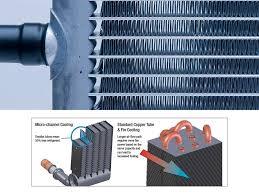Introduction: The Evolution of Heat Exchange Technology

Heating, ventilation, and air conditioning (HVAC) systems have rapidly evolved over the past few decades, responding to rising energy demands and the need for environmentally friendly solutions. Among the many innovations shaping this industry, microchannel coils have emerged as a key advancement. Their unique structure and performance benefits are transforming how modern HVAC systems function in residential, commercial, and industrial settings.
Understanding Microchannel Coil Design
Unlike traditional round-tube and fin coil systems, microchannel coils are constructed using flat aluminum tubes that contain multiple tiny channels running through them. These channels facilitate more efficient heat transfer due to a greater surface area in contact with the refrigerant. The second major reason these coils stand out is that microchannel technology allows the entire component to be manufactured from a single material—aluminum—enhancing durability and reducing corrosion risks. This streamlined design not only improves performance but also significantly reduces the coil's weight and physical footprint.
How Microchannel Coils Work
The primary function of microchannel coils is to act as a heat exchanger within HVAC systems. As refrigerant flows through the narrow aluminum channels, it absorbs or releases heat depending on whether the system is in cooling or heating mode. The increased contact area provided by the microchannels allows for faster and more efficient heat exchange. Additionally, the use of aluminum fins attached directly to the flat tubes improves airflow and thermal conductivity, making the entire process more energy-efficient.
Key Benefits of Microchannel Coils
Microchannel coils offer a host of advantages over conventional coil systems. First, they require significantly less refrigerant, which helps reduce both environmental impact and operating costs. Their compact size and lighter weight make them easier to install and transport. Furthermore, the aluminum construction minimizes galvanic corrosion, a common problem when different metals like copper and aluminum interact. The coils also provide excellent thermal performance, particularly in systems requiring high efficiency and reliability.
Applications Across Industries
Due to their efficiency and versatility, microchannel coils are being used across a wide range of industries. In residential HVAC systems, they contribute to quieter, more compact units with better energy ratings. In commercial buildings, they help reduce overall system size while maintaining performance. Industrial environments such as data centers, manufacturing facilities, and even automotive air conditioning systems rely on microchannel technology to ensure precise temperature control and durability under extreme conditions. The adaptability of these coils makes them suitable for nearly any application where space, performance, and reliability are crucial.
Environmental Impact and Regulatory Compliance
One of the driving forces behind the adoption of microchannel coils is the global push toward sustainable and eco-friendly technologies. These coils use up to 40% less refrigerant than traditional systems, aligning with international standards for reduced greenhouse gas emissions. They are also easier to recycle at the end of their life cycle, thanks to their all-aluminum construction. As governments impose stricter efficiency and environmental regulations, microchannel coils position HVAC manufacturers and users ahead of compliance curves.
Maintenance and Durability
Microchannel coils are not just efficient—they’re also designed for longevity. Their smooth aluminum surfaces reduce the accumulation of dust and debris, making maintenance simpler and less frequent. In addition, because they’re resistant to corrosion, they experience fewer breakdowns, helping lower maintenance costs and extend system life. For businesses and homeowners alike, this translates to fewer disruptions and better long-term value.
Conclusion: A Smart Investment for the Future
As HVAC systems continue to evolve in response to energy efficiency goals and environmental concerns, microchannel coils stand out as a powerful solution. Their advanced design, strong performance, and broad applicability across sectors make them a smart choice for forward-thinking system designers and users. Whether you're planning a small home system or a large-scale commercial installation, investing in microchannel technology ensures you’re building for the future—with better efficiency, less waste, and longer-lasting reliability.
- Business
- Art & Design
- Technology
- Marketing
- Fashion
- Wellness
- News
- Health & Fitness
- Food
- Games
- Sports
- Film
- Home
- Literature
- Music
- Networking
- Other
- Party
- Religion
- Shopping
- DIY & Crafts
- Theater
- Drinks
